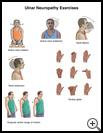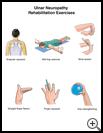
Ulnar Neuropathy Exercises
Your healthcare provider may recommend exercises to help you heal. Talk to your healthcare provider or physical therapist about which exercises will best help you and how to do them correctly and safely.
- Active neck rotation: Sit in a chair, keeping your neck, shoulders, and trunk straight. First, turn your head slowly to the right. Turn it gently until it starts hurting. Turn it back to the forward position. Relax. Then turn it to the left. Repeat in each direction 10 times.
- Active neck side bend: Sit in a chair, keeping your neck, shoulders, and trunk straight. Tilt your head so that your right ear moves toward your right shoulder. Keep tilting until it starts hurting. Then tilt your head in the other direction so your left ear moves toward your left shoulder. Make sure you do not rotate your head while tilting or raise your shoulder toward your head. Repeat this exercise 10 times in each direction.
- Neck flexion: Sit in a chair, keeping your neck, shoulders, and trunk straight. Bend your head forward, reaching your chin toward your chest. Hold for 5 seconds. Repeat 10 times.
- Neck extension: Sit in a chair looking ahead. Tilt your head back so that your chin is pointing toward the ceiling and then bring your head back to the starting position. If this exercise is uncomfortable, try placing your hands behind your neck while you look toward the ceiling. Be sure to sit up straight and keep your neck, shoulders, and trunk straight during the exercise. Repeat 10 times.
- Scapular active range of motion: Stand and shrug your shoulders up and hold for 5 seconds. Then squeeze your shoulder blades back and together and hold 5 seconds. Next, pull your shoulder blades downward as if putting them in your back pocket. Relax. Repeat this sequence 10 times.
- Scapular squeeze: While sitting or standing with your arms by your sides, squeeze your shoulder blades together and hold for 5 seconds. Do 2 sets of 15.
- Mid-trap exercise: Lie on your stomach on a firm surface and place a folded pillow underneath your chest. Place your arms out straight to your sides with your elbows straight and thumbs toward the ceiling. Slowly raise your arms toward the ceiling as you squeeze your shoulder blades together. Lower slowly. Do 2 sets of 15. As the exercise gets easier to do, hold soup cans or small weights in your hands.
- Wrist stretch: Press the back of the hand on your injured side with your other hand to help bend your wrist. Hold for 15 seconds. Next, stretch the hand back by pressing the fingers in a backward direction. Hold for 15 seconds. Keep the arm on your injured side straight during this exercise. Do 3 sets.
- Tendon glide: Do these exercises 3 times per day, 5 repetitions each.
- Hold your hand with your fingers straight and your palm facing away from you. Hold this position for 5 seconds.
- Flex the tips of your fingers and try to make a “claw” position. Hold 5 seconds.
- Return to Step 1 and hold 5 seconds.
- Make a full fist with your fingers. Hold 5 seconds.
- Return to Step 1 and hold 5 seconds.
- Keep your fingers straight, but bend only your knuckles, trying to make a duck-bill shape with your hand. Hold 5 seconds.
- Return to Step 1 and hold 5 seconds.
- Try to touch only your finger tips to your palm without making a full fist. Hold 5 seconds.
- Return to Step 1.
- Straight finger flexion: Make a right angle with your knuckles and keep your fingers straight. Hold this position for 5 seconds. Repeat 5 times.
- Finger squeeze: Practice squeezing items between each of the fingers on one hand. You can use paper, pens, and sponges. Hold for 10 seconds. Repeat 5 times for each finger.
- Grip strengthening: Squeeze a soft rubber ball and hold the squeeze for 3 seconds. Do 3 sets of 10.
Developed by RelayHealth.
This content is reviewed periodically and is subject to change as new health information becomes available. The information is intended to inform and educate and is not a replacement for medical evaluation, advice, diagnosis or treatment by a healthcare professional.
Copyright © 2016 RelayHealth, a division of McKesson Technologies Inc. All rights reserved.


